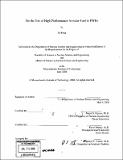| dc.contributor.advisor | Mujid S. Kazimi. | en_US |
| dc.contributor.author | Feng, Bo, 1971- | en_US |
| dc.contributor.other | Massachusetts Institute of Technology. Dept. of Nuclear Science and Engineering. | en_US |
| dc.date.accessioned | 2009-03-16T19:43:28Z | |
| dc.date.available | 2009-03-16T19:43:28Z | |
| dc.date.copyright | 2008 | en_US |
| dc.date.issued | 2008 | en_US |
| dc.identifier.uri | http://hdl.handle.net/1721.1/44791 | |
| dc.description | Thesis (S.M. and S.B.)--Massachusetts Institute of Technology, Dept. of Nuclear Science and Engineering, 2008. | en_US |
| dc.description | Includes bibliographical references (leaves 149-150). | en_US |
| dc.description.abstract | Recently, MIT's Center for Advanced Nuclear Energy Systems developed a new high burnup annular fuel that features both internal and external cooling. Implementation of this fuel design in current pressurized water reactors (PWRs) will allow power uprates up to 50% while maintaining or improving its existing thermal and safety margins. Each annular fuel assembly is arranged in a 13x13 array but has the same side dimensions as a 17x17 solid fuel assembly. Even at much higher power densities, the peak fuel temperatures are substantially lower and the MDNBR is comparable to that of solid fuel at 100% power. The main motivation for utilizing this fuel is the lower capital construction cost per kilowatt of electrical production compared to new reactors using solid fuel. To elaborate on the previous work, three remaining issues were addressed: the shutdown margin deficiency at 50% uprated power, effect of inner channel flow restrictions due to crud buildup and obstructions, and the economic impact of a fleet of reactors using high burnup annular fuel. All of the work was done using computer codes specializing in core neutronics, thermal hydraulics, and fuel cycle analysis. The reduced shutdown margin was found to be caused mainly by a reduction in control material volume coupled with a higher power density. This issue was resolved by changing the control material from traditional Ag-In-Cd to 25 wt% B-10 enriched B₄C. Increasing the control rod surface area was also investigated as a possible solution but it was revealed that any departure from the cylindrical shape would lead to a reduction in control volume which resulted in decreased rod worth. Simultaneous oxide growth and crud buildup on the inner cladding of the annular fuel was simulated in a whole core thermal-hydraulics model to determine the maximum thickness that the annular fuel can tolerate while maintaining an MDNBR greater than 1.3 under transient overpower conditions. | en_US |
| dc.description.abstract | (cont.) Under very conservative conditions, the maximum tolerable thickness was calculated to be a uniform 50 [mu]m layer of combined oxide and corrosion on the inner and outer cladding surfaces of the hot rod. Under full power conditions, the fuel was found to be able to tolerate a 35-40% blockage of the hot rod's inner channel. However, the prospect of plugging can be regarded as very hypothetical since debris filters in PWRs have a mesh spacing smaller than the fuel's inner channel diameter. The fuel cycle analysis code CAFCA SD was modified to include the capability to model the effect of LWRs using high burnup annular fuel on the US fuel cycle. At a given date, annular fuel can be introduced to the once-through fuel cycle via Generation II reactor uprates or construction of Generation Ill reactors. Results showed that constructing new 1.5 GWe reactors using annular fuel resulted in the greatest reduction in the cost of electricity due to its low capital construction cost. Total spent fuel was also reduced due to the reduced amount of reactors required to fulfill power demand. However, compared to traditional 4.5 wt% enriched solid fuel, using the higher enriched annular fuel for an entire fleet of LWRs would require a greater uranium mining rate. Overall, all three of these studies alleviate some concerns about annular fuel and serve to boost its attractiveness and feasibility for use on an industrial scale. | en_US |
| dc.description.statementofresponsibility | by Bo Feng. | en_US |
| dc.format.extent | 150 leaves | en_US |
| dc.language.iso | eng | en_US |
| dc.publisher | Massachusetts Institute of Technology | en_US |
| dc.rights | M.I.T. theses are protected by
copyright. They may be viewed from this source for any purpose, but
reproduction or distribution in any format is prohibited without written
permission. See provided URL for inquiries about permission. | en_US |
| dc.rights.uri | http://dspace.mit.edu/handle/1721.1/7582 | en_US |
| dc.subject | Nuclear Science and Engineering. | en_US |
| dc.title | On the use of high performance annular fuel in PWRs | en_US |
| dc.title.alternative | On the use of high performance annular fuel in pressurized water reactors | en_US |
| dc.type | Thesis | en_US |
| dc.description.degree | S.M.and S.B. | en_US |
| dc.contributor.department | Massachusetts Institute of Technology. Department of Nuclear Science and Engineering | |
| dc.identifier.oclc | 300311357 | en_US |
